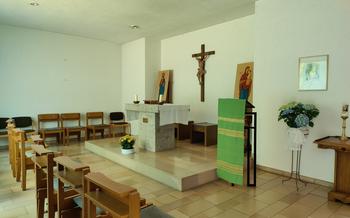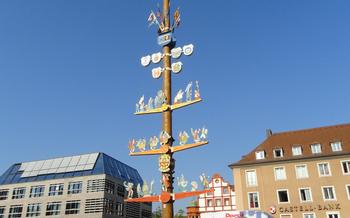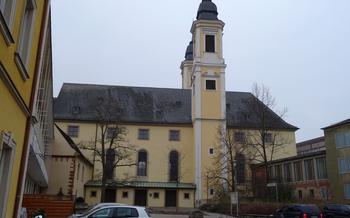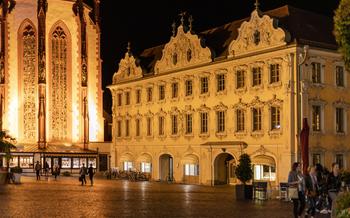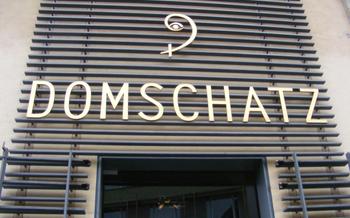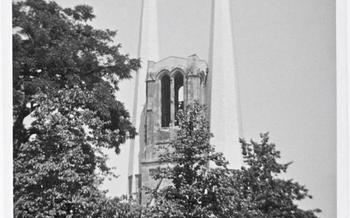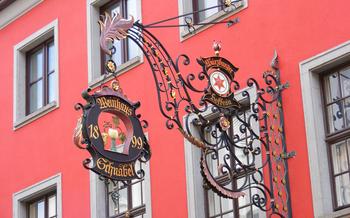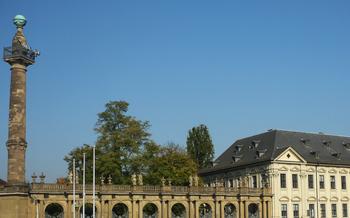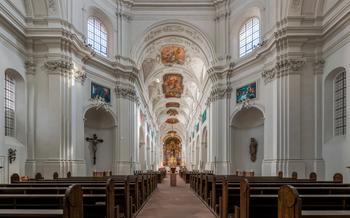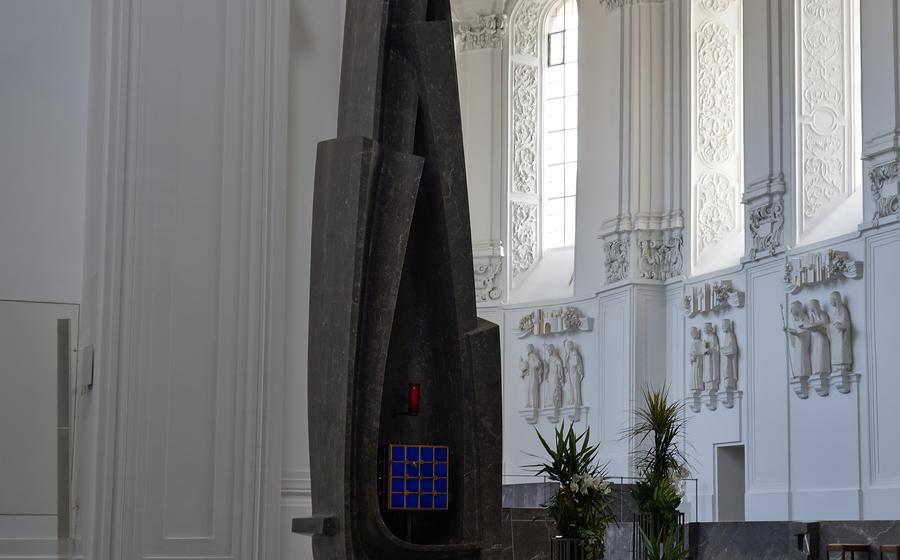
Würzburg Cathedral
- Würzburg Cathedral: A Majestic Masterpiece in the Heart of Germany
- Step Back in Time: The History of Würzburg Cathedral
- Marvelous Architecture: Exploring the Exterior
- A Sanctuary of Splendor: Unveiling the Interior
- The Altar of Tilman Riemenschneider: A Masterpiece of Devotion
- The Marienkapelle: A Hidden Gem Within
- The Cloister Garden: A Haven of Tranquility
- Guided Tours: Delving Deeper into the Cathedral's Secrets
- Music and Events: Experience the Cathedral's Cultural Vibrations
- Capture the Essence: Photography and Videography
- Souvenirs and Mementos: Taking a Piece of Würzburg Home
- Gastronomy Delights: Dining Near the Cathedral
- Nearby Attractions: Enriching Your Würzburg Experience
- Insider Tip: Unveiling the Secret Door
Würzburg Cathedral: A Majestic Masterpiece in the Heart of Germany
In the heart of Würzburg, Germany, stands a majestic edifice that has stood the test of time and emerged as a symbol of architectural brilliance and spiritual devotion: the Würzburg Cathedral. Its history is deeply intertwined with the city's rich cultural heritage, and its stunning architecture reflects the fusion of Romanesque, Gothic, and Baroque styles. The cathedral holds a profound spiritual and cultural legacy, serving as a place of worship, pilgrimage, and artistic expression for centuries. As you step into this magnificent cathedral, prepare to be awestruck by its grandeur and immerse yourself in the rich tapestry of history, art, and faith that it embodies.
Step Back in Time: The History of Würzburg Cathedral
The history of Würzburg Cathedral is a captivating tale that spans centuries, intertwining architectural styles, religious devotion, and resilience. Its origins can be traced back to the 8th century when Saint Kilian, an Irish missionary, arrived in Würzburg and established a Christian community. The first cathedral, a modest wooden structure, was built on the site of a pagan temple.
In the 11th century, Bishop Meginhard I initiated the construction of a larger cathedral in the Romanesque style. This grand edifice, completed in 1188, featured a basilica plan with a nave, two aisles, and a transept. The Romanesque elements, such as the rounded arches and sturdy pillars, can still be seen in the lower parts of the cathedral's towers.
During the 13th and 14th centuries, Gothic influences transformed the cathedral's appearance. The pointed arches, ribbed vaults, and flying buttresses added a sense of height and lightness to the structure. The Gothic choir, with its intricate tracery and large windows, is a testament to the skill and artistry of the medieval builders.
In the 17th and 18th centuries, the cathedral underwent a Baroque makeover. Under the direction of Prince-Bishop Johann Philipp von Schönborn, the interior was adorned with lavish decorations, including frescoes, sculptures, and elaborate altars. The Baroque transformation erased much of the Gothic character, but it left an enduring legacy of opulence and grandeur.
Tragically, during World War II, the cathedral suffered severe damage from Allied bombings. The roof was destroyed, and the interior was gutted by fire. The reconstruction efforts, which began in the 1950s, aimed to restore the cathedral to its former glory while incorporating modern safety features. Today, Würzburg Cathedral stands as a testament to the resilience of the human spirit and the power of faith to overcome adversity.
Marvelous Architecture: Exploring the Exterior
The exterior of Würzburg Cathedral is a testament to the architectural prowess of its builders. The majestic façade, adorned with intricate carvings and sculptures, sets the tone for the awe-inspiring experience that awaits visitors. Four soaring towers, each reaching towards the sky, dominate the cityscape, symbolizing the cathedral's spiritual significance and grandeur.
The interplay of architectural styles is a unique feature of Würzburg Cathedral. While the Romanesque foundations are evident in the sturdy structure and rounded arches, the Gothic influence is seen in the pointed arches and flying buttresses that add a sense of lightness and grace. The Baroque elements, added during the 17th and 18th centuries, contribute to the cathedral's opulent and elaborate appearance.
Intricate carvings and sculptures adorn the cathedral's exterior, showcasing the exceptional craftsmanship of the stonemasons. Gargoyles, grotesque figures, and scenes from the Bible decorate the façade, adding a touch of whimsy and intrigue to the overall design. The result is a harmonious blend of architectural styles that creates a visually stunning masterpiece.
A Sanctuary of Splendor: Unveiling the Interior
Step inside Würzburg Cathedral, and be prepared to be awestruck by the opulent Baroque interior. Every inch of the vast space is adorned with intricate details, creating a symphony of artistic wonders. The ceiling frescoes, painted by the renowned artist Giovanni Battista Tiepolo, are a masterpiece of the Rococo style. They depict scenes from the Old and New Testaments, bringing biblical stories to life with vibrant colors and dynamic compositions.
The altars and sculptures within the cathedral are equally impressive. The high altar, a Baroque masterpiece created by Balthasar Neumann, is a testament to the grandeur of the era. Its intricate carvings, delicate gilding, and life-size figures of saints create a sense of awe and reverence. Other notable sculptures include the Pietà by Tilman Riemenschneider, a poignant depiction of Mary cradling the body of Jesus, and the tomb of Prince-Bishop Julius Echter von Mespelbrunn, an elaborate monument adorned with allegorical figures and symbols.
Würzburg Cathedral is not just a visual feast; it also holds deep spiritual and cultural significance. The relics of Saint Kilian, the patron saint of Würzburg, are enshrined within the cathedral, making it a pilgrimage site for devout Catholics. The cathedral has also been a center of music and liturgy for centuries, hosting regular concerts, organ recitals, and choral performances. Its acoustics are renowned, making it a perfect venue for sacred music and spiritual contemplation.
The Altar of Tilman Riemenschneider: A Masterpiece of Devotion
Among the many treasures within Würzburg Cathedral, the Altar of Tilman Riemenschneider stands as a testament to the artist's exceptional skill and devotion. Created between 1501 and 1505, this magnificent altarpiece is a masterpiece of late Gothic art, showcasing Riemenschneider's intricate craftsmanship and profound understanding of human emotion.
The altar is adorned with a series of finely carved figures depicting scenes from the life of Christ, including the Annunciation, the Nativity, the Crucifixion, and the Resurrection. Each figure is meticulously crafted, with expressive faces and intricate details that capture the essence of the biblical narrative. The altar's central panel features a stunning representation of the Entombment, with the body of Christ being gently laid in the tomb by the grieving Mary and John.
Riemenschneider's attention to detail is evident in every aspect of the altar, from the delicate folds of the garments to the subtle expressions on the faces of the figures. The altarpiece is a testament to his mastery of the human form and his ability to convey deep emotions through his art.
Beyond its artistic significance, the Altar of Tilman Riemenschneider holds profound religious and theological meaning. It serves as a reminder of the central tenets of the Christian faith, highlighting the life, death, and resurrection of Jesus Christ. The altar's placement within the cathedral, at the heart of the sanctuary, underscores its importance as a focal point for worship and devotion.
For art enthusiasts and pilgrims alike, the Altar of Tilman Riemenschneider is a must-see attraction. Its exquisite craftsmanship, emotional depth, and spiritual significance make it one of the most treasured artworks in Würzburg Cathedral and a true masterpiece of the late Gothic period.
The Marienkapelle: A Hidden Gem Within
Tucked away within the grand expanse of Würzburg Cathedral lies the Marienkapelle, a hidden gem that beckons with its serene beauty and captivating history. Constructed in the Gothic architectural style during the 14th century, this intimate chapel exudes an aura of tranquility, inviting visitors to pause and contemplate amidst its sacred ambiance.
The Marienkapelle's interior is adorned with exquisite stained glass windows, casting a kaleidoscope of colors that dance upon the stone floor. Each window depicts intricate scenes from biblical narratives, inviting the faithful to reflect on the stories of faith and devotion. The soft glow of candlelight illuminates the chapel, creating a warm and welcoming atmosphere that encourages spiritual connection.
Beyond its aesthetic splendor, the Marienkapelle holds deep spiritual significance for the people of Würzburg. It serves as a place of pilgrimage and prayer, where the faithful gather to seek solace, offer thanksgivings, or simply commune with the divine. The chapel's serene atmosphere fosters a sense of peace and introspection, making it an ideal retreat for those seeking a moment of respite from the bustling world outside.
Whether you are a devout pilgrim, an art enthusiast, or simply a curious traveler, the Marienkapelle is a must-visit destination within Würzburg Cathedral. Its hidden beauty and sacred ambiance offer a unique and enriching experience that will leave a lasting impression on your soul.
The Cloister Garden: A Haven of Tranquility
Adjacent to the grandeur of Würzburg Cathedral lies the serene Cloister Garden, a hidden gem that offers a tranquil retreat from the bustling city. With its medieval origins, the garden holds historical significance, serving as a place of contemplation and relaxation for centuries.
Landscaped with meticulous care, the garden boasts a verdant expanse of manicured lawns, vibrant flowerbeds, and ancient trees that provide a refreshing canopy. Strolling along the garden's winding paths, visitors are enveloped in a symphony of colors and fragrances, creating a sensory experience that soothes the soul.
The Cloister Garden is a sanctuary for those seeking a moment of peace and reflection. Whether you choose to sit on a bench beneath the shade of a tree, immerse yourself in the beauty of the flowers, or simply wander aimlessly, the garden provides a serene haven to escape the demands of everyday life.
For those interested in history, the Cloister Garden offers a glimpse into the past. Its medieval origins are still evident in the layout and design, with remnants of the original cloisters visible throughout the garden. Visitors can imagine the monks who once tended to the gardens, finding solace and inspiration within these sacred grounds.
Today, the Cloister Garden remains a beloved spot for locals and tourists alike. Whether you're seeking a peaceful retreat, a place to admire nature's beauty, or a glimpse into Würzburg's rich history, the Cloister Garden is an oasis of tranquility that should not be missed.
Guided Tours: Delving Deeper into the Cathedral's Secrets
To fully appreciate the grandeur and rich history of Würzburg Cathedral, consider embarking on a guided tour. Knowledgeable guides will lead you through the cathedral's hallowed halls, sharing fascinating insights and anecdotes that bring the building's past to life.
Various tour options are available to suit different interests and time constraints. Standard tours provide a comprehensive overview of the cathedral's highlights, while specialized tours delve into specific aspects such as its architecture, art, or religious significance.
To book a guided tour, visit the cathedral's official website or inquire at the information desk inside the cathedral. Tours are typically offered in multiple languages, ensuring that international visitors can also benefit from this enriching experience.
To make the most of your guided tour, come prepared with questions and observations. Engage with your guide, and don't hesitate to ask for further explanations or recommendations. Remember to be respectful of other visitors and maintain a quiet demeanor during the tour.
By joining a guided tour of Würzburg Cathedral, you'll gain a deeper understanding of its architectural marvels, historical significance, and spiritual essence. It's an opportunity to connect with the cathedral's legacy and create lasting memories of your visit to this awe-inspiring masterpiece.
Music and Events: Experience the Cathedral's Cultural Vibrations
Würzburg Cathedral is not just a place of worship and historical significance; it is also a vibrant center for cultural events and musical performances. Throughout the year, the cathedral hosts a variety of concerts, festivals, and special events that showcase its impressive acoustics and artistic heritage.
Regular organ recitals and choral performances fill the cathedral with beautiful music, ranging from classical masterpieces to contemporary compositions. These concerts provide a unique opportunity to experience the cathedral's grandeur and acoustics while enjoying the talents of world-renowned musicians.
In addition to sacred music, the cathedral also hosts secular concerts and events, such as classical music concerts, jazz performances, and cultural festivals. These events attract both local residents and visitors, creating a lively and welcoming atmosphere within the cathedral's hallowed halls.
The annual Würzburg Cathedral Music Festival is a highlight of the city's cultural calendar, featuring a series of concerts and events that showcase the diverse musical traditions associated with the cathedral. This festival attracts musicians and music lovers from around the world, creating a vibrant and cosmopolitan atmosphere in Würzburg.
Attending a musical performance or event at Würzburg Cathedral is a unique and memorable experience. It allows visitors to appreciate the cathedral's cultural significance and its role as a platform for artistic expression and exchange. Whether you are a music enthusiast or simply seeking a unique cultural experience, the Würzburg Cathedral offers a diverse range of events and performances that will leave you inspired and uplifted.
Capture the Essence: Photography and Videography
When visiting Würzburg Cathedral, you may want to capture the stunning beauty of its interior and exterior through photography or videography. While you are welcome to do so, it is essential to be respectful of the sacred nature of the space and follow the guidelines set by the cathedral authorities.
-
Respect the Sanctity: Remember that Würzburg Cathedral is an active place of worship, and silence and reverence are expected within its walls. Please be mindful of ongoing services or ceremonies and avoid using flash photography or loud noises that may disturb worshippers.
-
Composition and Lighting: To capture the best shots, consider the composition of your photographs and the natural lighting conditions. Experiment with different angles and perspectives to create visually appealing images that showcase the cathedral's grandeur.
-
A Silent Symphony: While videography is permitted, please ensure that your equipment is set to silent mode to avoid any disruptions during services or events. Capture the ambiance of the cathedral through subtle movements and panning shots that convey its serene atmosphere.
-
Share Your Experience: After your visit, you may wish to share your photographs or videos with the world. Consider posting them on social media or creating a blog post about your experience at Würzburg Cathedral. Remember to tag the cathedral's official social media accounts and use relevant hashtags to connect with other enthusiasts.
Souvenirs and Mementos: Taking a Piece of Würzburg Home
As you depart from the awe-inspiring Würzburg Cathedral, you may wish to take a piece of its essence with you. The official cathedral shop, located within the premises, offers a treasure trove of souvenirs and mementos that will serve as lasting reminders of your visit.
From intricate postcards depicting the cathedral's majestic façade to informative books delving into its rich history and architecture, the shop caters to a variety of interests and preferences. You can also find a selection of religious items, such as rosaries, crucifixes, and prayer cards, that hold spiritual significance for many visitors.
By purchasing souvenirs from the cathedral shop, you not only take home a tangible memory but also contribute to the preservation and maintenance of this architectural masterpiece. The revenue generated from these sales helps fund ongoing restoration projects and ensures that future generations can continue to appreciate the cathedral's beauty and grandeur.
Whether you choose to adorn your home with a stunning photograph of the cathedral, gift a loved one with a unique piece of jewelry inspired by its intricate carvings, or simply take home a small token to remember your visit, the cathedral shop offers an array of options that will transport you back to this sacred space whenever you gaze upon them.
Gastronomy Delights: Dining Near the Cathedral
Indulge in Franconian Cuisine and Culinary Delights
A visit to Würzburg Cathedral is not complete without savoring the local culinary delights. The area surrounding the cathedral offers a variety of restaurants, cafés, and bakeries, allowing visitors to experience the vibrant gastronomic scene of the city.
For a taste of traditional Franconian cuisine, try one of the many restaurants in the historic Old Town. Here, you can savor dishes such as Schäufele (roasted pork shoulder) and Bratwurst (grilled sausage) paired with a glass of local wine from the Franconian wine region.
If you prefer a lighter meal, there are plenty of cafés and bakeries offering a range of sweet and savory treats. Enjoy a freshly baked pastry with a cup of coffee or tea while taking in the views of the cathedral.
For a more upscale dining experience, head to one of the restaurants with a view of the cathedral. These restaurants offer a unique opportunity to enjoy a delicious meal while admiring the grandeur of this architectural masterpiece.
Recommended Restaurants:
-
Zur Schwane: A traditional Franconian restaurant serving classic dishes in a cozy atmosphere. Located just a few steps from the cathedral.
-
Backöfele: A bakery and café offering a variety of fresh pastries, breads, and cakes. Known for its delicious Franconian apple cake.
-
Restaurant am Dom: A fine dining restaurant with a stunning view of the cathedral. Offers a modern take on Franconian cuisine with a focus on seasonal ingredients.
Nearby Attractions: Enriching Your Würzburg Experience
Würzburg offers a wealth of attractions beyond the cathedral, inviting travelers to discover its rich history, culture, and natural beauty. A leisurely stroll through the historic Old Town reveals charming cobblestone streets, colorful half-timbered houses, and picturesque squares. Immerse yourself in the town's vibrant atmosphere as you explore its boutiques, cafés, and traditional restaurants, savoring the flavors of Franconian cuisine.
Just a short walk from the cathedral, the magnificent Würzburg Residence stands as a testament to the grandeur of the prince-bishops who once ruled Würzburg. Admire the opulent Baroque architecture, explore the lavishly decorated state rooms, and marvel at the stunning gardens that surround this UNESCO World Heritage Site.
For a deeper dive into the region's history and culture, visit the Mainfränkisches Museum. This renowned museum houses a vast collection of artifacts and exhibits that showcase the rich tapestry of Franconian life, from prehistoric times to the present day. Immerse yourself in the region's diverse history, traditions, and artistic heritage.
If you have time, consider venturing beyond the city limits to explore the enchanting Romantic Road. This scenic route winds through picturesque villages, rolling hills, and medieval castles, inviting travelers to discover the heart of Bavaria. Würzburg serves as an ideal starting point for exploring this iconic road trip, which offers a chance to experience the region's natural beauty and cultural treasures.
Insider Tip: Unveiling the Secret Door
In the heart of Würzburg Cathedral, a hidden door awaits those who seek a unique and breathtaking experience. Tucked away in an inconspicuous corner, this door leads to a spiral staircase that winds its way up to a secluded platform. As you ascend, anticipation builds, and the sense of discovery intensifies. Once you reach the top, you'll be rewarded with a panoramic view of Würzburg and its surroundings that will take your breath away. The city's iconic buildings, the meandering Main River, and the verdant hills of Franconia stretch out before you, creating a picturesque landscape that will forever remain etched in your memory. The secret door holds a fascinating history, dating back to the cathedral's construction in the Middle Ages. It was initially intended as a means for the city's watchmen to keep a vigilant eye over the city, ensuring its safety and security. Over time, the door fell into disuse and was forgotten, becoming a hidden gem waiting to be rediscovered. If you're an adventurous traveler seeking an off-the-beaten-path experience, uncovering the secret door is a must. It offers a unique perspective of Würzburg and provides an insight into the cathedral's rich history. So, as you explore the wonders of Würzburg Cathedral, keep an eye out for the hidden door and unlock the secret that lies beyond.
